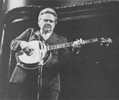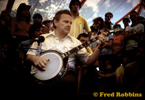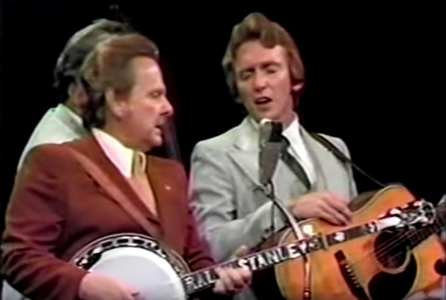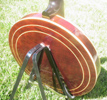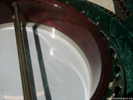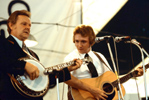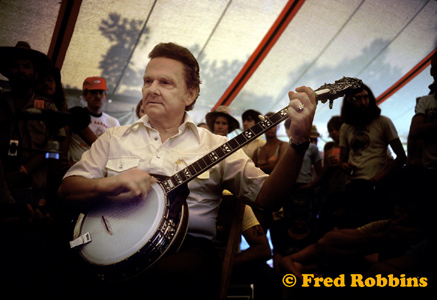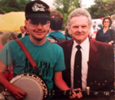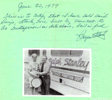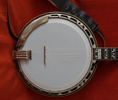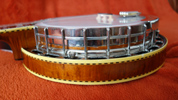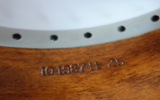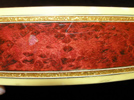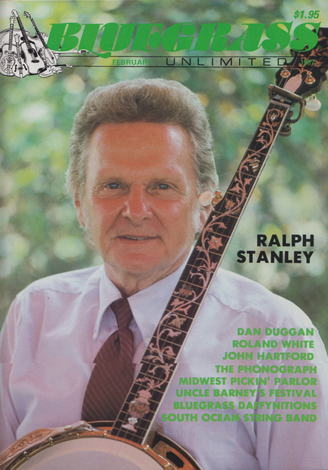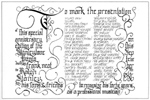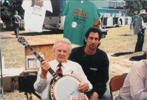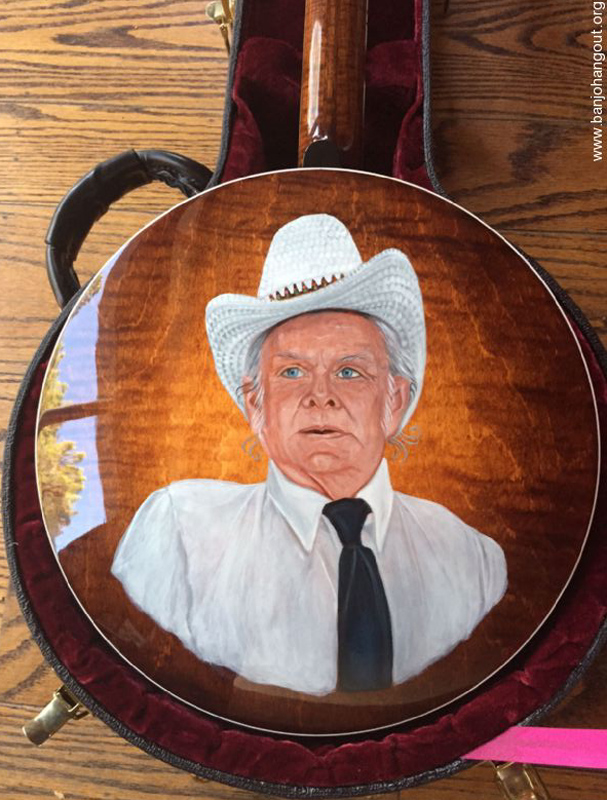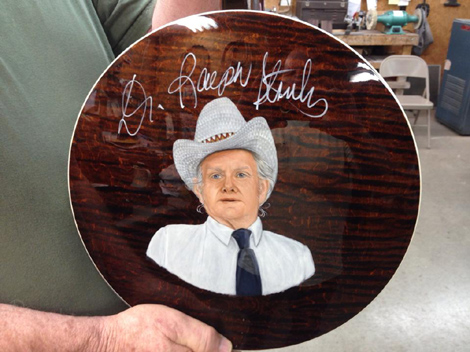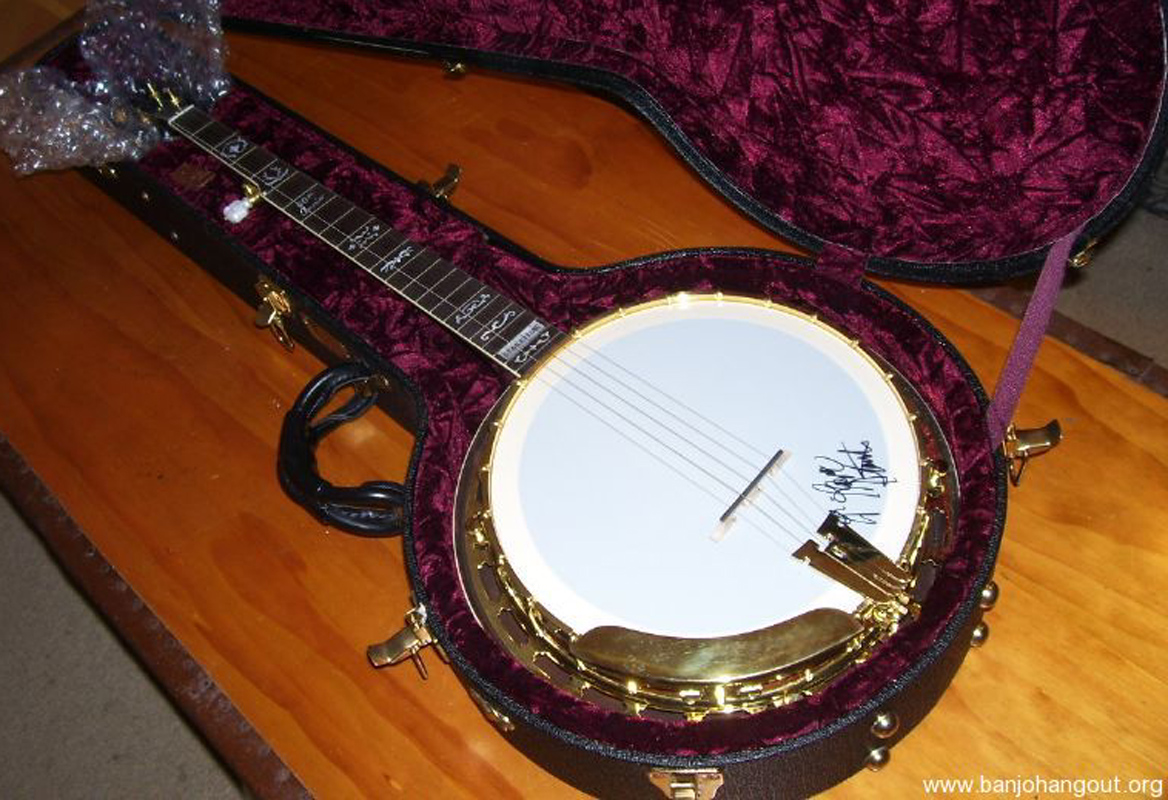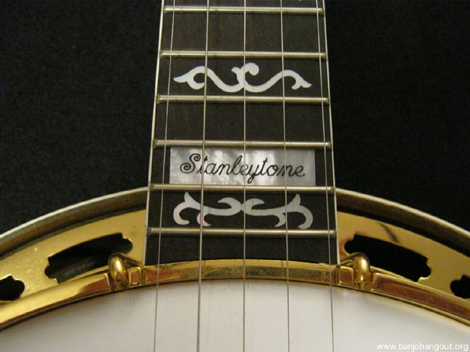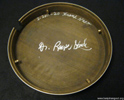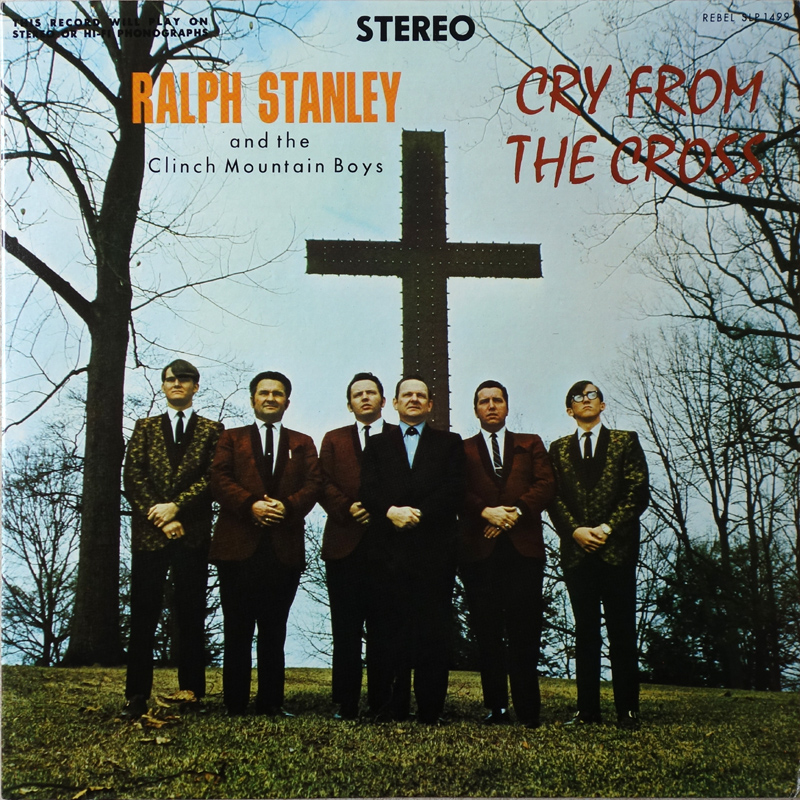- Bill Gatton Chevy Show
- Carter Stanley Interview - 1966
- Jim Kent's film 'Ralph Stanley's Bluegrass Festival'
- New WCYB Recording
- Pound Va. 1972 - Video
- Replica Rebel T-Shirt
- R.I.P. Ralph
- Roy Lee Centers Last Show
- Song & Memory Books
- Stanley Brothers - WCYB Acetate
- Stanley Standard - Carter Stanley Memorial Issue
- Suwannee River Jamboree
- Up In The Cloud - 1957-62
The Stanleytone Banjo
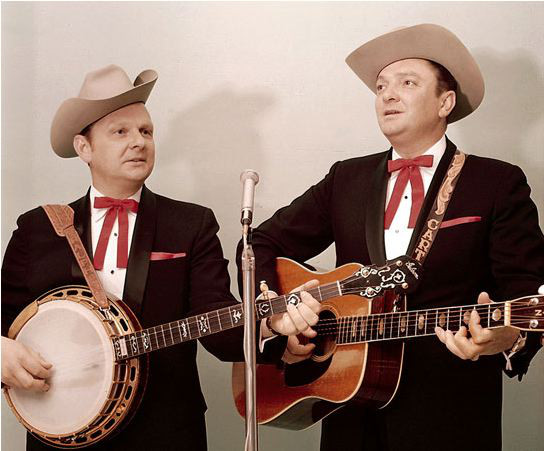
This is kind of a work in progress - If anyone has any corrections or can provide additional info / or pictures etc, please get in touch.
In particular if anyone wants to share details of their Stanleytone - # and date, and any special features, anecdotes etc. that would be great!
We're also on the lookout for anyone with Stanleytone banjo's for sale... as there's a couple of folk who're looking to buy one!
Please get in touch via the Contact page.
Thanks
Ivor
During Ralph's long career although he played many different banjo's, including 10 to 15 Gibson Mastertone's,[1] probably the most well known was his 1929 Gibson Style-5 archtop with it's 'Wreath' pattern inlay. Ralph picked up this instrument on a tour of the West Coast in Sept. 1962, trading it for a 1923 Gibson flathead. When he made the trade the Style 5 didn't have a neck, so Ralph got Tom Morgan to make one, and he pretty much played that banjo exclusively on all his recordings from then through to the mid '70s.[2]
Sometime in the mid-'70s (probably 1976 or '75), the Style 5 - or as Ralph used to sometimes (mistakenly) refer to it 'Granada Deluxe' - instrument was stolen from a festival at Bean Blossom, whilst he and Bill Monroe went for lunch. Bill made an appeal from the stage for the banjo's return[3] and within a week it'd luckily had been returned to him.
The temporary loss of his beloved Style 5 seems to have prompted Ralph to try out other banjo's, commenting in 1980 he said:- "In a way I got afraid to carry my old one, y'see it got stolen one time... and I've been offered a lot of money for that banjo. And it could get stolen, y'know, and I've had it a long time and I'd like to keep it, and to keep it in good shape. This (Stanleytone) one suits me just as well, as far as the sound. It plays easy and I'm sort of preserving it."[4]
At first Ralph seems to have used a few different banjo's in addition to the Stanleytone range. He was featured in an advert in 'Bluegrass Unlimited' Aug. 1977, with a picture of him playing a Stelling 'Gospel' flathead from a gig in Friendship, In. in Jul. '76 (This is likely to be Stelling #140, a 'Gospel' flathead). Later, in Nov. 1978 Pickin' magazine featured an ad with Ralph endorsing Gold Star banjo's, with a picture showing him playing one at the Great American Music Hall in San Francisco. In total Ralph played three Stellings, including one at the Dec. 1976 Lincoln Memorial University seminars where he said he'd been playing it since Aug '76:- "Geoff Stelling invited me to use this banjo. It's as good as any of the new banjos. I wouldn't say it's better than the old ones."[5] Another one Ralph owned is the 'Gospel' arch-top #777 which can be seen in the photo used in the 'Masters Of The Five String Banjo' book (p. 98) or O Bluegrass Celebration CD cover.[6]
Interviewed for the Banjo News Letter by Donald Nitchie, Geoff Stelling explained: "It was some time in May or so in 1976 when Ralph Stanley contacted me to make him a banjo to replace the RB-5 that had been recently stolen. I was glad to oblige and made him a Gospel model that had a flathead tone-ring. That did not fill the bill, as I expected, since Ralph always played on an archtop tone-ring banjo. So I made him another one with the archtop ring and he liked it a lot. That was in July of 1976. Within a year of that, Ralph asked if I could make a lighter banjo with an archtop ring, so I designed one and had it made to deliver on June 28, 1978. This is a photo of Ralph holding that banjo. It was a gold plated, engraved Gospel with a carved cross on the resonator. So, in the space of three years, Ralph owned and played three different Stelling banjos."[7]
Around about the same time as Ralph was playing the Stelling, he also began playing the Stanleytone which would ultimately become his instrument of choice. In 1980 he commented at the Berkshire Mountain Bluegrass Festival Banjo workshop, when asked if he still played the Stelling:- "Hardly ever. I still have a Stelling, but I play this (Stanleytone) about all the time now. The Stelling's are a fine banjo, they're well made, and I like the sound of a Stelling. It seemed that they never did just fit me exactly, whereas this one here is made exactly the same dimensions, neck and everything like my old (Gibson) one, just more natural to me. But the Stelling is a fine banjo."[4]
The Stanleytone range of banjos, which Ralph played from the mid-late '70s onwards, were built and crafted by Frank Neat. According to a few sources the very first Stanleytone was built in 1975,[8] but I think it may have been slightly later - probably 1977. Frank had known Ralph since the mid sixties, when he played banjo in Bryan Wilson's Kentucky Ramblers who were house band at the Bean Blossom 'Brown County Jamboree'.[9] From becoming acquainted with Jim Faulkner and then J.D. Crowe, Frank began to get started with making replacement 5-string necks for old Gibson 4-string tenor banjos, and as Gibson pots became scarcer, progressed to making complete banjo's with off-the-shelf metal hardware.[10]
Ralph later explained to John Wright in his 'Travelling the High Way Home' book:- "How the Stanleytone banjo got started, I met Frank Neat I guess twenty-five or thirty years ago in Indiana, Bean Blossom, and he come around and talked to me. I was playing this old Mastertone and he said, 'That's the best sounding banjo I ever heard. I'll tell you what I'd like to do. It's a long ways off, but some day I'd like to make you a banjo and give it to you, one that'll sound just like it. If you'll let me take that old banjo home with me and go through it, look it over, I'll make a direct copy of it.'"
"Well, he did. I let him take it. He took my old one. And years later, why he made that banjo and gave it to me. So then we just came up with the idea. He said. 'Why don't you let me make you some of them and sell them?' So that started the Stanleytone. But the one he made me, he put my name on the neck, got 'Ralph Stanley'. Oh it was a pretty thing. But I couldn't play it. I'm dumb, I couldn't find the positions. And I told him I couldn't and I said, 'I'm going to sell it and then I'll just pay you for a another one.' He said ok, so I sold it to a boy I believe in North Wilkesboro, North Carolina. He's got it now. Got 'Ralph Stanley' in great big letters.[11]
The First Stanleytone (and prototypes):
c1977
Inlay: 'Ralph Stanley'
Head-stock: 'F. Neat' (?)
Tailpiece: Clamshell (?)
Metal Finish: Nickel/chrome
The very first Stanleytone, looks like it's the one Ralph played on the 2nd June 1977 K.E.T. TV 'Bluegrass Bluegrass' show. From the youtube video It's difficult to make out the head-stock, but it looks like it may be the same as the early Stanleytone's with 'F. Neat' at the top and the fretboard inlay is consistent with Ralph's description above.
Presumably around about the time of the first 'proper' Stanleytone's, there were also 2-3 banjo's built to a similar specification, but without the 'Stanleytone' inlay block and with just 'F. Neat' on the head-stock. One which came up for sale recently had a more reddish finish to it, with concentric circles on the resonator, and a laminate wood rim, with a layer of ebony for tone ring to rest on. As with the 'standard' Stanleytones the neck is 5-piece laminated maple with 'Bela Voce' inlay and maple resonator.
One of the distinctive characteristics of the all the Stanleytone's is the thin laminated neck, which is shaped by hand and varies slightly from banjo to banjo. Ralph much preferred the thinner necks, which Frank laminates from a maple block which is cut and glued back together so that any tendancy in the wood to twist is self-correcting. The lamination also makes the neck stronger, while the fret scale is slightly different to the standard Gibson scale and the fret wire is thinner too.
Original 'Chrome' and 'Gold':
1978 to 1991
50 Chrome (nickel) and 50 Gold
Inlay: 'Bela Voce' with 'Stanleytone' block at 21st fret - sans serif (Chrome) or script (Gold).
Head-stock: Early copies 'F. Neat'. later copies 'F. Neat' + 'Ralph' in Mother of Pearl (Chrome) / 'F. Neat' + 'Ralph' in Mother of Pearl (Gold)
Tailpiece: Clamshell or Waverly (Chrome) and Kershner (Gold)
It seems that originally the plan was to produce just 30 of the nickel/chrome banjos as a collectors item, as Ralph mentions having #11 of the 30 in the 1980 Berkshire Festival banjo workshop.[4] This was then later increased to 50 nickel (or 'Chrome' as Ralph used to refer to them) and 50 'Gold' - probably sometime between 1981 and 1983, as the 'Gold' Stanleytone featured on the cover of The Stanley Sound Today has 'F. Neat' on head-stock, whilst 1983's Child Of The King 'Chrome' has 'F. Neat + Ralph'. According to Frank, Ralph felt that adding his name on the head-stock would help improve sales.[10]
The numbering of the original version of the banjo was not necessarily sequential. The second Stanleytone was #7 'Chrome', with '1-1978-7' (Jan 1978 #7) embossed into the inner rim of the banjo pot. Other instruments in the 'Chrome' range include '3-1978-9' (No. 3 - Sept 1978); '6-1979-14' (No. 14 - June 1979); '11-1981-20' (No. 20 Nov 1981); '6-1984-16' (No. 16 - June 1984); '09-1985-21' (No. 21 - Sept 1985; '10-1987-25' (No. 25 - Oct 1987), with the last one being sold at the UK Edale festival in June 1991.[12]
The only Gold one's I know of are '11-1984-25' (#25 Nov. 1984); #17 which is said to be from 1983; and #2 which is featured on the cover to 1981 album The Stanley Sound Today.
I'd guess that production in 1978/9 was probably limited as Frank was still working at Arvin Industry in Indiana, and took phased retirement in 1979, so that he could buy a plot of land near Russell Springs, Ky. and build his house/workshop.[10] In Mar. 1980 he took up instrument building full time, and has been making superb hand-crafted banjo's ever since.
In John Wright's book 'Traveling The High Way Home' Frank gave some details about the original Stanleytone, saying that the Rim's were three-ply hard rock maple and that the rim and resonator were made by Jim Cox in Maine. The flanges came from Stewart McDonald and Tension Hoops from either Jim Cox or Stewart McDonald. The tone rings were made by Woodhaven Industry in Oregon, and tuning pegs are either Schaller or from Stewart McDonald.
The Stanleytones were all played by Ralph, and usually advertised during gigs during the band's merchandise sales-pitch, for instance on the 1st Aug 1987 Midsummer Bluegrass Festival, Grass Valley, CA Ralph announced that he was selling "#39 of 50 that's gonna be made" but didn't specify whether it was a 'Gold' or 'Chrome' instrument.
At the UK June 1991 Edale Friday night concert - Ralph says last the Stanleytone for sale is the last one of the 100 and that Curly Ray Cline has #3 and had already been offered $12,000 for it. This seems to have been an exaggeration however, as the 'Chrome' models today seem to fetch in the region of $4000 - $4,500. No doubt the 'Gold' version with it's intricate engraving and gold sparkle binding would fetch more...
#17 (Gold) was owned by Todd Lawson of The Lawson Brothers, who recorded two excellent Stanley influenced LP's in the '80s and performed on occasion at Ralph's 'Hills Of Home' festival; Alex Leach, the former banjo player with Ralph Stanley II & The Clinch Mountain Boys plays # 20 (Chrome) which was originally owned by Col. Larry Roark and has recently been fitted with Cam-D tuners by Little Roy Lewis; and #25 (Chrome) was originally bought by Kenny Bohling who now runs the Lakota Leather instrument straps. I'm proud to say that I'm the current owner of #25, which apparently was sold back to Ralph and then re-sold by him/Steve Sparkman in 2008. At the time Kenny first approached Ralph about buying a Stanleytone the price was $2,000 but by the time he'd saved up that amount, it'd increased to $2,500. Ralph took pity however on the young lad and still let him have it at the original cost... as long as he promised not to tell!
40th Anniversary - Special
1986
Gold plated
Inlay: Vine mother of pearl with abalone flowers at each marker position.
Head-stock: Neat + Ralph(?), abalone flower / humming bird and abalone truss rod cover
Tailpiece: Kershner (?)
This was a one-off special Stanleytone built to celebrate Ralph's 40th anniversary as a professional musician. It was payed for by fans and friends and presented to him at the 'Ralph Stanley Homecoming' festival in McClure 26-28th Sept. 1986. The instrument which was featured on the cover of the Feb. 1987 issue of 'Bluegrass Unlimited' is now on display at the Ralph Stanley Museum in Clintwood, Va..
Interviewed at Ralph's festival the preceding May 1986 for the 'Traveling The High Way Home' book, Frank Neat told John Wright that the neck and resonator on this was made of fiddleback walnut, rather than the standard curly maple that was normally used on the Stanleytone's. (Ralph's 1929 Style 5 was made of walnut). It also is said to feature a two-piece flange, rather than the regular one-piece, and a Kershner tailpiece in order to accommodate the engraving.
The most striking feature of this Stanleytone (and the subsequent 'Signature' series) is the intricate inlay which shows a flower vase near the head and a vine weaving it's way down the neck, with abalone flowers at each of the usual fret-marker positions. The head-stock too has an abalone rose and a hummingbird. Again according to the John Wright interview, this inlay was the work of Bryan England from Leitchfield, Ky.
The idea of using abalone to mark the regular fret position was so that it's iridescent nature would (hopefully) make it stand out from the mother pearl and make it easier for Ralph to play as he relied on the fret markers rather than the dots on the side of the neck to see where he was on the neck.
40th Anniversary
1989 - c1994
30 gold plated
Inlay: 'Wreath' pattern with '40th Anniversary at 7th fret and 'Stanleytone' script block at 21st fret.
Head-stock: 'Neat' + 'Ralph' with an abalone truss rod cover.
Tailpiece: Kershner
In addition to the special '40th Anniversary' banjo, there was also a series of '40th Anniversary' Stanleytone's, with some beautiful gold engraving and binding work.
Ralph can be seen holding one of these banjo's on the cover to his 1989 Like Father, Like Son album. Mitchell Van Dyke now owns this banjo and tells us that it's #1 in the series. Ralph also used it on the Pray For The Boys album, and it's stamped in the rim '71989-1', so dates from July 1989. If you look closely to the resonator of this one, you can see that Ralph has dedicated it twice on the inside & also signed the outside too.
#1 also has "Ralph Stanley" engraved into the abalone truss rod cover.
#19 is a left handed model which was made for Gary Bates in 1994 (aka Stanleytone on the Banjo Hangout). Gary is another top-notch 'Stanley' style picker and has produced, in my opinion, the best tab transcriptions of Ralph's playing. For more details check his Banjo Hangout photo section!
#24 was bought from Ralph at a show at the Aladdin Theater, Portland, Oregon (08 Feb 1995) by Charlie Kamerman. This has the serial number '11995#24', so was made in January 1995. You can find some neat pictures of this banjo & other ephemera on Charlie's flickr page.
#27, which was the last one to be made and the instrument shown in the photo's on the top right, is owned by Zach Wright.




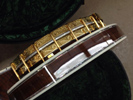








50th Anniversary
c1996/7
50 gold plated
Inlay: 'Wreath' pattern with '50th Anniversary at 7th fret and 'Stanleytone' script block at 21st fret.
Head-stock: 'Neat' + 'Ralph' with abalone truss rod cover.
Tailpiece: Kershner
There seems to have been two variations in the '50th Anniversary Stanleytones with a few copies being 'Deluxe' variants with 'upgraded' antique binding on the neck and resonator, amber colour tuner buttons and inlaid flower purfaling in the rear of the head-stock. Like the previous '40th Anniversary' there is elaborate gold engraving, but the '50th Anniversary' also includes a painting of Ralph on the back of the resonator.
#1 in this series is owned by Steve Sparkman and is kind of special, as Frank Neat fitted a pre-war Gibson tone ring to it, which he had lying around in his workshop. #50 was built in 1997 for Jarrod Church and can be heard on his Clinch Mountain Banjo CD. As far as I know this was one of only 3 left handed Stanleytone's to be made. Another top notch picker, Zach Wright plays #33 on his Colonel Zach Wright CD - and of course with Sammy Adkins and the Sandy Hook Mtn. Boys.
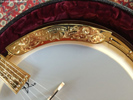




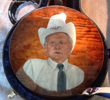


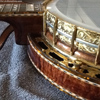
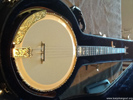
Signature
c1998-2003
32 + 1 gold plated
Inlay: 'Tree Of Life'
Head-stock: 'Neat'
Tailpiece: Presto
The signature series includes the 'Tree Of Life' inlay comparable to the '40th Anniversary special' that was presented to Ralph and a hand painted picture of him on the resonator, similar to the '50th Anniversary'. It also adds Ralph's signature to the resonator.
The first to be made wasn't numbered so can be considered as a prototype. It was owned by Ralph and later given to Mr. Chesky on stage, who had it signed a couple of shows later.
It seems that the 'Signature' range of Stanleytone's came about due to the high demand for the '50th Anniversary' edition. Ralph is pictured playing one of them at the Winterhawk 1998 festival, and on a recording of the festival from the 19th July, he explains:- "Ladies and gentlemen, I reckon I've been known to have distributed some of the finest five-string banjos throughout the country, that there's ever been. We're pickin' two more here today in the same place. I had a 50th Anniversary and it sold out real quick. I didn't expect it to go so fast and I got letters and telephone's from people, y'know and I only made 50 of 'em, said er 'we need a banjo - we want one of your banjo's'. I said I can't make another 50, I promised that. Well they said 'make something else'. So we decided to make a very limited supply of what Steve and me are playing today. Look what a pretty fingerboard it's got... and it's called the 'Signature' series. I'll just show you the back of it... there's the signature in there in gold. I'm playing #1 and Steve's playing #2. We just got 'em the day before yesterday... and their going fast, we still got both of 'em. Anyone that would like to take one home with you, see us at the record table..."
The following year at the Podunk Bluegrass Festival - Hartford Connecticut (24th Sept 1999) - James Alan Shelton also advertises the banjo which Ralph was playing as "a limited edition 50th Anniversary Stanleytone 'Signature' series banjo and the reason it is a 'Signature' series is (that) Ralph's autograph is on it on the back, before the finish is sprayed on... this is a hand crafted custom made banjo built down in Kentucky by a gentlemen by the name of Frank Neat and it's all gold plated and engraved, made from curly maple and has all that mother of pearl inlay in the neck. Ralph is going to offer 30 of these for sale and the one we have tonight is #9 and if you'd be interested in owning one of these banjo's I'll have it over at the table. Ralph, if you would, turn it around and show 'em how pretty that thing looks on the back. That handsome's cat's picture's on the back of all of these, so if you'd like to own one, just come and see me after the show. Thank you."
The serial number stamped into the rim for #10 shows it having been made 19 June 1999 (i.e. "061999"). On a video from 31 July 1999 at the '10th Annual Northwoods Bluegrass Festival' at Manitowish Waters, WI, Ralph mentions that the banjo he's playing is #10 and that he'd sold it "last night". (i.e. at the 'Northeastern Bluegrass Festival' in Canal Fulton, OH.) The bill of sale however is dated 27 May 2000, the last day of Ralph's "30th Anniversary" Hills Of Home festival at McClure, Va. This raises the possibility that the original sale either didn't materialise, or was delayed... in which case #10 could have been the Signature model banjo Ralph can be seen playing on youtube at his 15 Jan 2000 Opry induction.
The final banjo in this series was numbered #32 and is dated 20 Feb 2003. It was also owned by Mr. Chesky, so he had both the first and last 'Signature' models to be made!
Thanks to Alec Thibodeaux for the info on #10 & Cynthia Chesky.




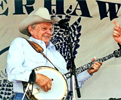








60th Anniversary
c2005
20 gold plated
Inlay: 'Wreath' + 'Stanleytone' block at 21st fret.
Head-stock: 'Dr. Ralph'
Tailpiece: Kershner
I've only seen a couple of these later models for sale, one came with a printed certification saying it was #13 and sold on the 27th May 2005, the other #4 has the serial no "04-2004-#4" so was made in April 2004. Unlike the previous Gold plated instruments, the finish is plain with no engraving, and it featured a rosewood fretboard rather than the more usual ebony.
I believe that the gentleman that used to do the fancy engraving on the earlier models had died by the time this model was produced.
Thanks to Dave RS for the update on #4. That brings the total of known Stanleytone banjo's in the UK to 3!

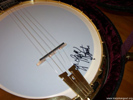
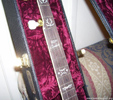

Hills Of Home
c2007-9
25 gold plated
Inlay: 'Dr. Ralph Stanley' + 'Stanleytone' script block at 21st fret.
Head-stock: 'Hills Of Home'.
Tailpiece: Presto
According to James Alan Shelton's stage announcement from 16th Nov 2007 at the Sheldon Concert Hall, St. Louis, Mo. there were 25 of the 'Hills Of Home' model, and on this particular gig Steve Sparkman was playing (and selling) #7. They were also mentioned in the 'Special Feature' on Frank Neat on Steve Sparkman's Stanley Style Banjo DVD from 2008.
#8 is dated August 2007, with '8-07-8' being embossed into the inner rim of the banjo pot.
#12 is a left handed model, which was made for Jarrod Church c2009.
The 'Hills Of Home' model included plain gold plated metal work and a presto tailpiece.
Thanks to Anita Shane for the photos of #8.










Unknown
c2011
?? gold plated
Inlay: 'Wreath pattern' + 'Stanleytone' script block at 21st fret.
Head-stock: 'Neat' + 'Ralph' with abalone truss rod cover.
Tailpiece: Kershner
After the 'Hills Of Home' model, I think there was another series, possibly just referred to as Stanleytone's... #20 was built in Feb. 2011 and originally owned by a young Jonny Mizzonne of the Sleepy Banjo Boys. You can see him playing Ralph's Midnight Ramble on youtube, from when he was just 9 years old.
In total there were about 300 Stanleytone's built, so unless I've got some of the quantities wrong or I'm missing a particular range, there should have been about 40 of these later types.
And Finally...
Although the Stanleytone's are no longer being made, Frank still produces a 'Mountain Doctor' archtop banjo, which is to the same high quality spec... and looks very similar to the original run of Stanleytone's with 'Bela Voce' inlay and plain gold finish. He & Ricky Neat can also supply Stanleytone spec'd bridges, which are a lot thinner than most bridges I've seen, and go a long way to getting that latter 'Stanley' sound.
Of course, Frank has also in the past produced the 'Chief' banjo for Sonny Osborne and done banjo work for several banjo maestro's, including J.D. Crowe. But that's a different story!
For more information on Frank Neat's banjo's check out his website: http://neatbanjos.com/ and their facebook page: https://www.facebook.com/neatbanjos/. The Frank Neat interview in John Wright's book 'Traveling The High Way Home' is also worth reading.
Many of the photo's on this page have been taken either from the Neat Banjo's facebook page, or from classified ad's from the Banjo Hangout - the 'world's largest, most active banjo community'. Additional thanks also go to: the 'Banjo Newsletter', Mitchell Van Dyke, Greg Bean, Kenny Bohling, Canton Breeden, Jarrod Church, Cynthia Chesky, Alec Thibodeaux, Anita Shane, Charlie Kamerman & Fred Robbins.

[1] Pete Wernick's interview with Ralph in the 'Masters Of The 5-String Banjo' book (p. 104)
[2] Comments from Steve Sparkman / Mitchell Van Dyke in the 'Notes & Queries' section of 'Bluegrass Unlimited' June 2017 (p. 16). The only later recordings I can think of that were done with other banjo's are the Live In Japan and John Henry albums.
[3] Ralph Stanley and Eddie Dean's book 'Man Of Constant Sorrow' (p. 413-416)
[4] Berkshire Festival 1980 Banjo Workshop. See http://frobbi.org/slides/DrRalph/index.html
[5] Pickin' magazine Aug. 1977 - see http://www.clinchmountainecho.co.uk/articles/pickin_aug_1977.php
[6] http://www.stellingbanjo.com/blog/a-stelling-banjo-chronology/
[7] Doug Nitchie - 'Callous Thumb: Ralph Stanley' article in the Aug. 2016 'Banjo Newsletter': https://banjonews.com/2016-08/callous_thumb_august_2016.html
[8] Banjo Hangout 'The First Stanleytone Banjo' - https://www.banjohangout.org/archive/259464
and https://youtu.be/77c-qFsTR9E
[9] Thomas A. Adler's book 'Bean Blossom: The Brown County Jamboree and Bill Monroe's Bluegrass Festivals' (p. 80)
[10] Frank Neat interview in John Wright's book 'Traveling The High Way Home' (p. 208-217)
[10] Ralph Stanley interview in John Wright's book 'Traveling The High Way Home' (p. 72)
[12] Ralph's on-stage announcement on the Friday night at Edale https://youtu.be/hPlc4MIDtCI.











